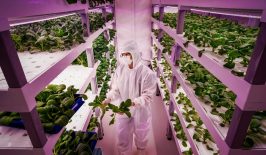Bioengineers have developed meat-free steaks made from vegetable proteins, made in a 3D printer, which mimic both the taste and texture of real beef.
How will the world be fed as the population grows? Ensuring access to nutritious and sufficient food for everyone is one of the challenges that our societies will face in the future and the increased demand for animal protein in particular is set to have huge knock-on effects on the environment. Livestock farming already contributes significantly to global warming, and is one of the main causes of deforestation, land degradation, water pollution and desertification around the world. Not to mention the public health and animal welfare impacts that meat production has. Is there a technological solution to our dangerous growing appetite for meat?
The idea of creating meat “without the animal” has been for a while now, and is one of the one of the hottest areas of investment and technology advancement in the world. What may have sounded like science fiction a few years ago has already become reality. Several startups are already “growing” lab-grown meat from animal cells, while Impossible Food and Beyond Meat, both California based startups, have taken the lead with plant-based burgers that are said to taste just like meat. Their products are currently in our supermarkets’ shelves and in on the menu at mainstream fast food chains.
And how, just like they’ve disrupted other areas of life, 3D printing technologies have just entered the kitchen to produce a brand new category of meatless meat. What 3D printing brings to the table is the ability to simulate the unique texture of real meat. While creating a meat-like sausage, burger patty or meatball is one thing, creating a steak that feels, looks and tastes like the real thing is quite another.
Novameat, a Barcelona-based startup, has developed a technology for 3D printing a plant-based steak that is said to mimic the texture, appearance, nutritional and sensorial properties of fibrous animal meats. “While I was researching regenerating animal tissues through bioprinting technologies for biomedical and veterinary applications, I discovered a way to bio-hack the structure of the native 3D matrix of a variety of plant-based proteins to achieve a meaty texture,” explained Novameat’s founder Giuseppe Scionti, in a press release.
His creation is entirely plant-based, made out of protein powder which is made into a paste and then extruded onto a printing plate. Investors certainly seem to think there’s something in it. The Spanish startup recently received an undisclosed amount of funding from New Crop Capital, which is also a main investor of other plant-based food solutions.
Another company working on 3D-printed meat is Redefine Meat, who are based in Israel. The startup is working on a technology that will produce a plant-based meat alternative, made from plant protein sources, fat and water. Here again, 3D printing gives the products (what they call “alt-meat”) a realistic meaty texture. more precisely steaks, roasts and stews from natural and sustainable ingredients. The company plans to sell their 3D “meat printing” machine and protein to meat companies who can print and distribute the products to retail outlets and restaurants, starting in 2020. While their current focus on beef, they plan to expand their offerings to include tuna, pork and more. Redefine Meat claims that its 3D printed meat has a 95% smaller environmental impact than animal meat, no cholesterol, and is more affordable.
Perhaps the most important question is – will people eat it? It will have to look, and taste, pretty convincing if it’s going to be enough to make people switch from the real deal. Currently, the appearance of the steaks is probably not enough to convert a committed meat-eater. Maybe, until the appearance is adapted and fine-tuned its probably going to appeal more to the world’s “flexitarians” or people who are consciously trying to reduce their meat consumption – rather than cut it out entirely.
And plant-based 3D-printed meat alone probably isn’t going to save the planet. What we also need to have is a discussion about how to drive sustainability throughout all of agriculture and food production, including encouraging crop diversity, exploring alternative approaches like vertical farming and reducing the amount of food that needlessly goes to waste.





